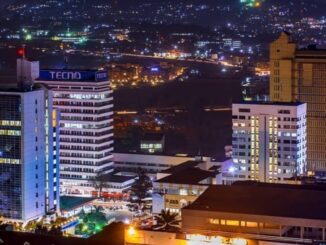
Africa is home to some of the fastest-growing economies globally, driven by factors such as an increasing population, abundant natural resources, and progressive economic reforms. In this article, we explore the top 10 fastest-growing African economies, highlighting the opportunities and challenges investors may face in these markets. Understanding the unique dynamics of each country is crucial for investors looking to tap into the immense potential offered by Africa’s emerging markets.

- Rwanda
Growth Rate: 10.9% (IMF, 2021)
Rwanda’s impressive economic growth is driven by its commitment to good governance, investment in infrastructure, and efforts to diversify the economy. The country has experienced remarkable economic development since the 1994 genocide, with GDP per capita increasing by 216% between 2000 and 2020 (World Bank, 2021).
Investment opportunities abound in sectors such as agriculture, tourism, ICT, and renewable energy. Rwanda has made significant progress in developing its tourism sector, with the Rwanda Development Board (RDB) reporting a 10% increase in tourism revenue in 2019 compared to 2018.
Some challenges investors may face in Rwanda include limited access to finance, a small domestic market, a high dependence on foreign aid, and a landlocked geographic location, which can increase transportation costs. However, the Rwandan government is working on various initiatives to address these challenges, such as improving regional connectivity through infrastructure projects and establishing special economic zones to facilitate trade and investment, the government’s pro-business policies and commitment to reducing red tape make Rwanda an attractive investment destination. For instance, Rwanda ranked 38th globally in the World Bank’s 2020 Ease of Doing Business report, the second-highest ranking in Africa.

- Kenya
Growth Rate: 7.5% (IMF, 2021)
Kenya’s strong economic growth is driven by its diversified economy, strategic location as a regional hub, and a vibrant private sector. The country is the largest economy in East Africa and the 6th largest in Africa (World Bank, 2021). Major infrastructure projects, such as the Standard Gauge Railway and the Lamu Port-South Sudan-Ethiopia Transport (LAPSSET) Corridor, are expected to enhance Kenya’s position as a regional trade hub.
Investment opportunities in Kenya span various sectors, including infrastructure, agriculture, renewable energy, and technology. Kenya’s growing tech ecosystem, dubbed “Silicon Savannah,” has attracted significant international attention and investment in recent years.
Investors may face challenges such as corruption, high public debt, and insecurity. Kenya ranks 124th out of 180 countries in the 2020 Corruption Perceptions Index by Transparency International. Inflation reached 5.7% in 2021 (World Bank, 2021), and public debt has grown significantly, reaching over 65% of GDP in 2020 (IMF, 2021). However, Kenya’s well-developed financial sector, growing middle class, and commitment to economic reforms make it an appealing market for investors.
- Benin
Growth Rate: 7.2% (IMF, 2021)
Benin’s economy has experienced steady growth, driven by its agricultural sector and its role as a transit hub for trade in the West African region. The government has focused on improving the business environment, investing in infrastructure projects, and promoting sectors such as tourism, energy, and agriculture for further diversification.
Opportunities for investment in Benin include agribusiness, renewable energy, and the digital economy. The country’s ongoing reforms and commitment to creating a more business-friendly environment are expected to encourage more foreign investment in these sectors.
Investors may face challenges such as inadequate infrastructure, a small domestic market, and political risks. Benin ranks 149th out of 190 countries in the World Bank’s 2020 Ease of Doing Business report. Despite these challenges, Benin’s strategic location, ongoing economic reforms, and investment in infrastructure projects make it an attractive market for investors.

- Ivory Coast
Growth Rate: 7% (IMF, 2021)
Ivory Coast’s robust economic growth is primarily driven by its agriculture and natural resources sectors, particularly cocoa, coffee, and palm oil. The country has implemented various structural reforms and infrastructure projects aimed at boosting economic diversification, creating a more business-friendly environment, and improving living standards. Key investment sectors include agriculture, infrastructure, renewable energy, and manufacturing.
Investors in Ivory Coast may face challenges such as political instability, corruption, and inadequate infrastructure. The 2020 Corruption Perceptions Index by Transparency International ranks Ivory Coast 106th out of 180 countries. Nevertheless, the country’s ongoing commitment to economic reforms, diversification, and infrastructure development make it an appealing destination for investment in West Africa.
- Burkina Faso
Growth Rate: 6.9% (IMF, 2021)
Burkina Faso’s economic growth is primarily driven by its agriculture and mining sectors, particularly gold production. The
country has implemented various reforms aimed at improving the business environment and promoting sectors such as manufacturing, renewable energy, and infrastructure development.
Investment opportunities in Burkina Faso include agriculture, mining, renewable energy, and infrastructure. The government’s ongoing commitment to economic reforms and diversification is expected to create a more favorable environment for investment in these sectors.
However, investors may face challenges such as political instability, security concerns, and inadequate infrastructure. Burkina Faso ranks 151st out of 190 countries in the World Bank’s 2020 Ease of Doing Business report. Additionally, the country faces security threats from extremist groups in the region, which could impact investor confidence. Despite these challenges, Burkina Faso’s growing economy and ongoing reforms offer potential investment opportunities in the country.
- Uganda
Growth Rate: 6.7% (IMF, 2021)
Uganda’s economic growth is driven by its diversified economy, abundant natural resources, and growing consumer market. Key sectors for investment include agriculture, oil and gas, renewable energy, and tourism. The discovery of oil reserves in the Albertine Graben region has the potential to significantly boost Uganda’s economy and create new opportunities for investment.
Challenges for investors in Uganda include corruption, political instability, and inadequate infrastructure. Uganda ranks 116th out of 180 countries in the 2020 Corruption Perceptions Index by Transparency International and 127th out of 190 countries in the World Bank’s 2020 Ease of Doing Business report. In addition, the country faces intermittent political instability and civil unrest.
However, Uganda’s strategic location within the East African Community (EAC) and its ongoing commitment to economic reforms make it an attractive market for investors seeking opportunities in the region.
- Ethiopia
Growth Rate: 6.3% (IMF, 2021)
Ethiopia has consistently been one of the fastest-growing economies in Africa over the past decade. Its rapid economic growth can be attributed to a combination of factors, including government-led infrastructure projects, investment in agriculture, and expanding industrial and service sectors. In 2021, Ethiopia became the 12th largest economy in Africa by GDP (World Bank, 2021).
Opportunities for investment can be found in areas such as agro-processing, textiles, renewable energy, and information technology. Ethiopia has made significant strides in developing its industrial parks, such as the Hawassa Industrial Park, which is dedicated to the textile and apparel sector and has attracted leading global brands.
However, challenges for investors in Ethiopia include political instability, high inflation, foreign exchange shortages, and an underdeveloped private sector. In addition, the recent conflict in the Tigray region has led to increased uncertainty and risks for investors. Investors need to be aware of these challenges and tailor their strategies accordingly to navigate the Ethiopian market successfully.

- Senegal
Growth Rate: 6.1% (IMF, 2021)
Senegal’s stable economic growth can be attributed to its strategic location, political stability, and ongoing investments in major infrastructure projects, such as the new Dakar-Diamniadio toll highway and Blaise Diagne International Airport. Key sectors for investment in Senegal include agriculture, renewable energy, tourism, and infrastructure.
Investors in Senegal may face challenges such as inadequate infrastructure, limited access to finance, and a small domestic market. Senegal ranks 123rd out of 190 countries in the World Bank’s 2020 Ease of Doing Business report. However, the country’s political stability, strategic location, and commitment to infrastructure development make it an attractive destination for investors in West Africa.
- Ghana
Growth Rate: 5.4% (IMF, 2021)
Ghana’s growth is fueled by its stable political environment, robust institutions, and the recent discovery of oil and gas reserves. The country has attracted significant foreign direct investment (FDI) in recent years, with FDI inflows reaching $2.6 billion in 2020 (UNCTAD, 2021).
The country offers investment opportunities in agriculture, manufacturing, energy, and infrastructure. For example, Ghana’s “One District, One Factory” initiative aims to promote industrialization by establishing at least one industrial enterprise in each of the country’s 260 districts.
Challenges for investors in Ghana include infrastructure deficits, high public debt, and currency volatility. Inflation reached 8.6% in 2021 (World Bank, 2021), and public debt has grown significantly, reaching over 70% of GDP in 2020 (IMF, 2021). Nevertheless, Ghana’s business-friendly environment and commitment to economic reforms make it a promising market for investors.
- Tanzania
Growth Rate: 4.9% (IMF, 2021)
Tanzania’s growth is driven by a stable macroeconomic environment, investment in infrastructure, and a focus on industrialization. The country has made significant progress in increasing access to electricity, with the national electrification rate reaching 75% in 2020, up from just 30% in 2010 (World Bank, 2021).
The country presents investment opportunities in sectors such as agriculture, mining, energy, and tourism. Tanzania is the fourth-largest gold producer in Africa, and recent discoveries of natural gas reserves provide significant opportunities for investment in the energy sector.
Investors may face challenges such as policy uncertainty, regulatory hurdles, and a limited skilled workforce. The World Bank’s 2020 Ease of Doing Business report ranks Tanzania 141st out of 190 countries. However, Tanzania’s abundant natural resources and efforts to improve the business climate make it an attractive destination for investment.
Conclusion
Africa’s fastest-growing economies present numerous opportunities for investors in various sectors, such as agriculture, manufacturing, energy, and technology. However, these markets also come with their unique set of challenges, including political instability, corruption, and infrastructure gaps.
Investors looking to tap into the immense potential of Africa’s emerging markets must conduct thorough research, understand the local context, and tailor their investment strategies to navigate the complexities of each country successfully. By doing so, investors can capitalize on the growth opportunities in these dynamic markets and contribute to the ongoing economic transformation of the African continent.
Stay up-to-date on the latest developments in Africa’s economic landscape and gain insights on investment opportunities and challenges by subscribing to “Africa Business Insights”.



